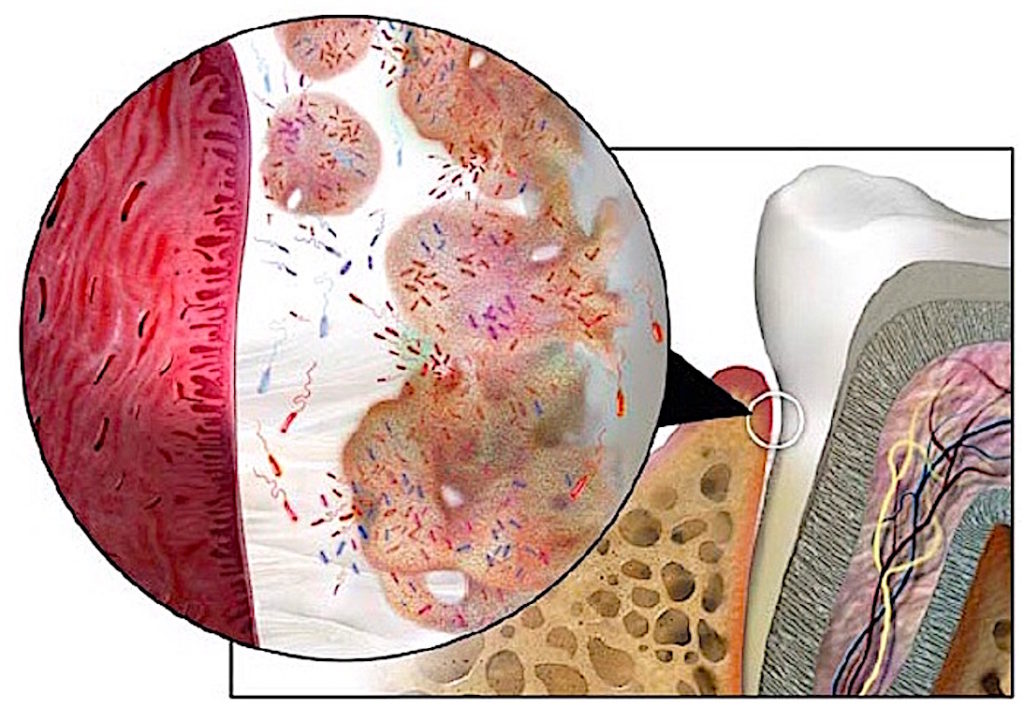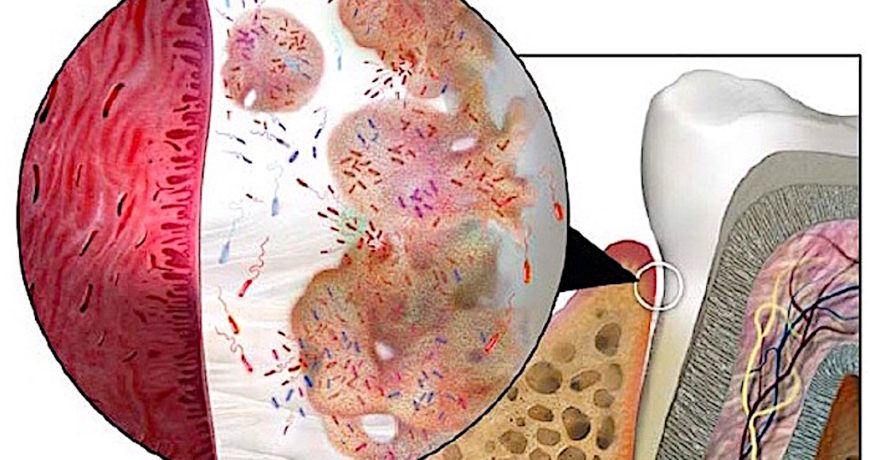Drynaria – Unique Benefits of Bone-Building Herb for Gingivitis and Osteoporosis 8

In addition to causing pain and embarrassment, gum disease is now linked to a number of chronic inflammatory disorders arising from the growth of bacterial colonies in the mouth, including heart disease, diabetes, prostatitis, rheumatoid arthritis and chronic obstructive pulmonary disease (COPD).
Gum Disease
Gum disease starts when bacteria gather to form a “biofilm” that coats tooth surfaces at or below the gum line. These bacteria emit toxins that cause the body to mount an inflammatory response that begins to eat away at gum tissues, leading to gingivitis. Eventually, if the source of inflammation is not brought under control, the process results in the destruction of supportive bone structures (alveolar bone) that are needed to firmly anchor teeth in place. As these retaining tissues break down, once-firm teeth become loose, leading to increasing inflammation, loss of bone and eventually requiring extraction.
Loss of Jaw Bone
Loss of alveolar jaw bone is a localized form of osteoporosis, and supplements that support bone and gum growth can aid in restoring healthy alveolar bone to firmly anchor the teeth to prevent tooth loss and aid in chewing.
Over the centuries traditional doctors in China developed a number of herbal formulas to promote bone healing in fractures.
Referred to as “bone-knitting herbs,” these specialized formulas were given to speed up bone healing in fractures resulting from farm work, martial arts training, wars and construction work.
Modern researchers have identified the physiological actions by which traditional bone-knitting herbs work to rebuild bone tissues. Over time a large body of contemporary research has focused on one particular herb that is particularly effective at restoring bone loss arising from periodontal disease. The herb, Drynaria fortunei, is referred to in China as GuSuiBu, literally meaning “mend broken bones.”
Early scientific research on Drynaria focused on its ability to rebuild healthy bone to reverse the effects of osteoporosis.
Bone building, called remodeling, requires maintaining a careful balancing act between the destruction of weak, old bone (resorption) and the manufacturing of new, healthy bone (regeneration). When old bone is broken down at a faster rate than new bone is created, the result is osteoporosis.
Drynaria has been shown to improve bone rebuilding in several examples of excessive bone loss.
- Inhibiting Osteoclast Function: Osteoclasts are specialized cells that break down old bone to provide a space for healthy new bone. This is a normal, healthy process unless it outpaces the body’s ability to create new bone tissue. Drynaria has been shown to support healthy osteoclast function without entirely halting it, as bisphosphonate drugs do.
- Stimulating Osteoblast Function: Osteoblasts are specialized cells within bones that deposit new, healthy bone in the spaces created by osteoclasts. When osteoblasts can’t keep up with the pace of bone resorption, loss of bone tissue accelerates, resulting in osteoporosis. Drynaria has been shown in multiple studies to stimulate osteoblasts to produce more healthy bone tissue.
- Osteogenesis (Mesenchymal Cells): Osteogenesis is the process by which mesenchymal cells in bone marrow differentiate to become new osteoblast cells capable of producing new bone tissue. Not only is it necessary to stimulate osteoblasts to produce bone, but to also stimulate bone marrow to produce new osteoblast cells to replace those lost to disease or apoptosis, the process of natural cell death. Several studies have shown that Drynaria stimulates osteogenesis to provide bones with an adequate supply of new osteoblasts.
- Loss of Ovaries: Accelerated bone loss in recently menopausal women is associated with the loss of ovarian function. Extracts of Drynaria have been shown to provide an anti-osteoporotic effects in female mammals following the loss of ovaries.
Gum Disease and Alveolar Bone Regeneration
Impressed with the growing body of studies supporting Drynaria’s role in rebuilding healthy bone, researchers began to examine its application in periodontal disease, where bacterial proliferation and inflammation contribute to the destruction of gum tissues and underlying alveolar bone.
One group of scientists has investigated Drynaria to determine if it could counter alveolar bone loss caused by E. Coli bacteria. Their study revealed that the herb suppressed bone resorption and promoted bone regeneration.
Additional studies have shown improved alveolar bone growth. In a paper published in 2011, scientists reported that Drynaria enhanced differentiation of osteoblastic cells, resulting in the growth of new, non-calcified bone-like matrix at the base of a tooth. In their summary the scientists concluded that Drynaria could be a supplementary medicine for periodontal therapy based on its ability to reduce alveolar bone resorption while supporting the bone-building effects of osteoblasts.
More recently, researchers have reported that Drynaria effectively increased the number of osteoblasts and reduced the number of osteoclasts, providing an overall gain in new bone growth.
Periodontal Ligament
The periodontal ligament is a structure within the gums that helps bind the teeth to the underlying bone. However, this ligament also produces cells that become bone tissue, so it’s importance in dental health is extremely significant. In 2010 researchers used an electron microscope to reveal that naringin, one of the active ingredients in Drynaria, actively stimulates protein synthesis and metabolism of human periodontal ligament cells.
These researchers had previously shown that naringin can promote proliferation and differentiation of human periodontal ligament cells by enhancing alkaline phosphatase (ALP) activity. Alkaline phosphatase activity is an important osteoblast function in building bone.
Similar research at a different hospital also concluded that naringen could promote growth of new human periodontal ligament cells via alkaline phosphatase activity.
Because the periodontal ligament not only serves as structural support for the teeth, but also as a source for regenerating bone tissue, reversing destruction of these ligaments during gum loss is central to halting and repairing periodontal disease.
Additional Health Benefits of Drynaria
- Rheumatoid bone loss: During rheumatoid arthritis, bone is lost due to inflammation. One study has shown that the total flavonoid active ingredients in Drynaria can prevent and treat osteoporosis in rheumatoid arthritis.
- Diabetes and osteoporosis: Researchers throughout the world have identified strong links between diabetes and osteoporosis. One study in China revealed the ability of the total flavonoid content of Drynaria rhizomes to promote osteogenic differentiation of bone marrow cells into bone-building osteoblast cells at different concentrations of exposure to glucose. The study also revealed that Drynaria counters this damage at the highest concentrations of glucose and concludes that the flavonoids may help as a therapy for diabetic osteoporosis.
- Diabetes and periodontitis: There is substantial interaction between diabetes and periodontal problems. Other research supports additional contributions of Drynaria to gum health due to an ability to ameliorate damage from high blood sugar.
Drynaria for Dental Health
Based on a significant body of contemporary research, Drynaria rhizome has been shown to aid in halting and reversing the destructive loss of gums and alveolar bone that are the hallmark of periodontal disease. Drynaria has also been shown to promote the growth of alveolar bone and the periodontal ligament to aid in restoring and maintaining dental health.
Combined with other herbs in a synergistically balanced formula, such as GingiPhase, Dyrnaria can support optimal periodontal health while addressing a wide range of disorders known to interact with, and contribute to, periodontal disease.


Hello Tango
Thank you for the article on Drynaria.
I live in South Africa, and have been looking for a source of Drynaria without success.
Can you recommend a sohrce or product perhaps?
Thank you.
Sheila Hughes
research in the internet and you will come across other companies that sell traditional chinese Medicine herbal combinations. This tango product is good. DO not use Drynaria by itself.
Dear Leonore,
Both our GingiPhase and OsteoPhase contain Drynaria as the featured herb. We feel that formulas in general work better than single herbs as other ingredients support the primary actions of the main herb, but also add results that improve outcomes. That is why you will see different herbs in the gum formula GingiPhase that are not in OsteoPhase and vice versa. However, it is perfectly fine for people to just use Drynaria by itself or to augment a suitable TCM formula with additional Drynaria.
Hi Sheila, sorry to say we cannot ship to South Africa due to import restrictions, and I’m not aware of what local sources are available for you. If we learn anything more regarding availability in SA we’ll get in touch.
I live in British Columbia and am wondering where I could find drynaria
Thank you
Hi Cindy, Drynaria is a major component of our GingiPhase gum and tooth support formula, available through our store here – https://www.tangoherbs.com/product/gingiphase-120-caps/
Why do you say do NOT use Drynaria by itself? What harm can it cause?
Dear Alma,
Please see my correction reply to the comment by Leonore above. We use Drynaria in formulas in combination with other ingredients, which is by far the best way to include Drynaria in you herbal supplement regimen. However, Drynaria can certainly be used by itself and should be very safe when purchased from a reputable herbal supplier.
John Steinke, L.Ac., Tango Product Development Director